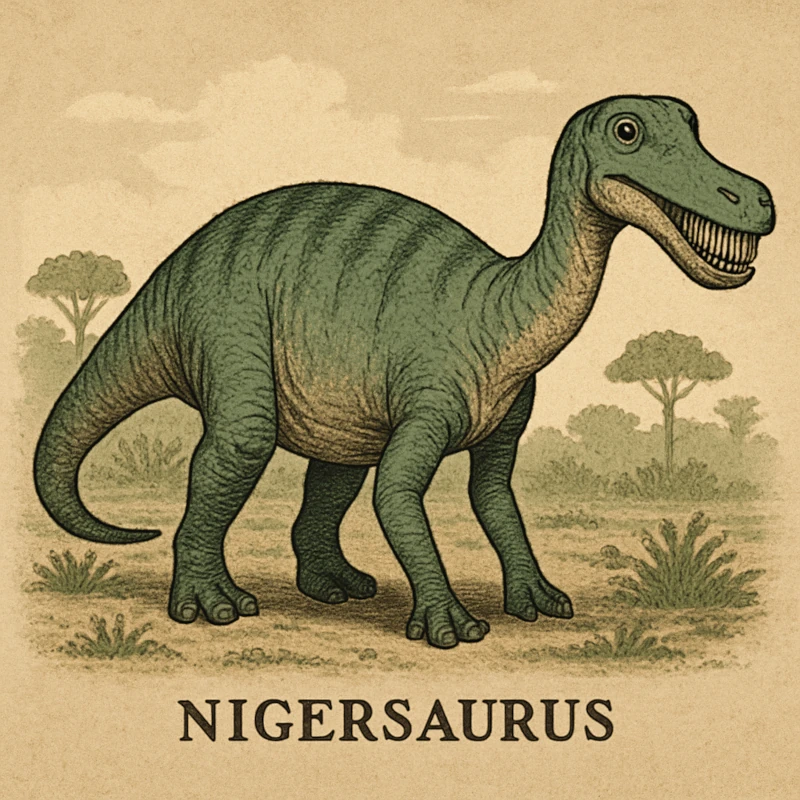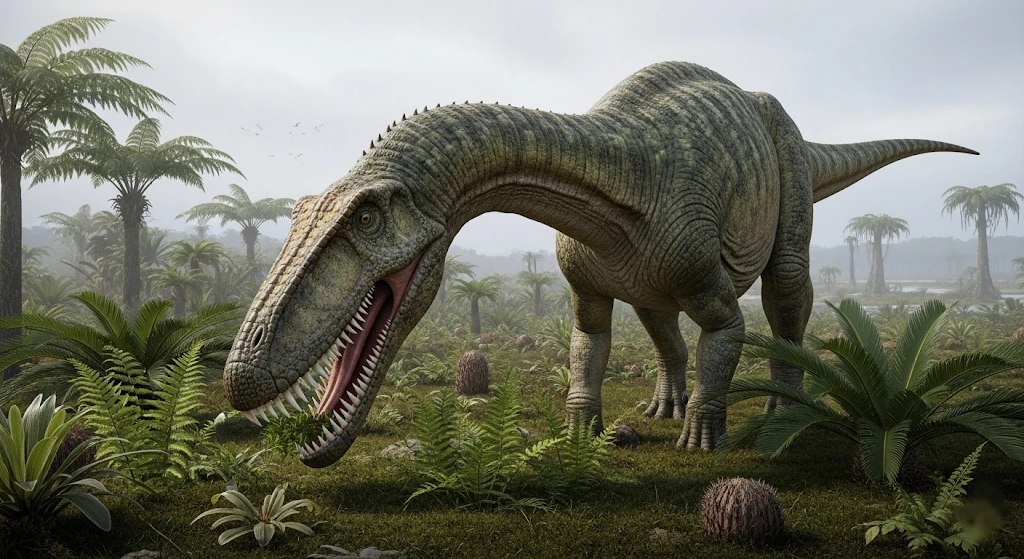Nigersaurus: The Dinosaur with 500 Teeth

What dinosaur has 500 teeth? Nigersaurus is the dinosaur with 500 teet. It’s even more fascinating than you think. Living about 110 million years ago during the Early Cretaceous, this plant-eating sauropod evolved an astonishing 500 replaceable teeth and a jaw perfectly shaped to graze low vegetation. Let’s explore how this “ground‑level giant” thrived with a mouth unlike any other dinosaur’s.
What is Nigersaurus?
Nigersaurus was a plant-eating sauropod dinosaur that lived about 110 million years ago during the Early Cretaceous period in Africa. Its most remarkable feature was its 500 teeth, which were continuously replaced throughout its life. Its jaw was specially shaped to efficiently crop low-growing vegetation. With a short neck and wide muzzle, Nigersaurus was well adapted to grazing close to the ground.

Discovery and Naming
In 1997, French paleontologist Philippe Taquet and his team unearthed fossils in Niger’s Ténéré Desert—giving birth to the name Nigersaurus, meaning “Niger lizard.” This dramatic discovery reshaped understanding of unique sauropod diversity in Africa during the Early Cretaceous.
A Mouth Full of 500 Teeth
Nigersaurus’s signature feature? A wide, straight-edged muzzle packed with up to 500 closely-packed teeth, arranged for efficient ground‑level grazing. These slender, leaf‑shaped teeth were continuously replaced throughout its life—ensuring it never ran out of cutting power while chewing tough plants.
These thin, sharp teeth were exquisite for the particular herbivorous diet of the dinosaur.
Nigersaurus had a unique feeding strategy. Mouths are usually broad and flat, unlike the usual pointed snouts of other herbivores.
Its teeth were organized such that they raked and cropped vegetation very well. Moreover, most of the teeth at the front of their mouths were replaced regularly throughout his life.
This replacement is very important in an herbivorous diet that requires heavy wear on teeth.
Unique Body Structure for Low Grazing
Nigersaurus’s body was built for grazing close to the ground:
-
Length: ~9 m (30 ft); Weight: ~4 tons
-
Short neck & flat skull for sweeping low vegetation
-
Sturdy legs & long tail provide low‑browsing stability
-
Ideal for slow, steady feeding on dense plant mats
Thriving in the Early Cretaceous Landscape
In the Early Cretaceous (~110 M years ago), Africa was humid and low‑lying plant hordes covered the Gondwanan landmass. While taller sauropods munched treetops, Nigersaurus occupied a unique niche—specializing in ground‑level grazing on ferns, cycads, and horsetails. This reduced competition and defined its ecosystem role.
It lived in Africa and walked on Earth during the Early Cretaceous period. As the simple but massive landmass of Gondwana began to split apart, Africa became an increasingly isolated area. Then, this was a time when the climate was warm and humid with a low-growing herbaceous plant community in which herbivorous dinosaurs such as Nigersaurus thrived.
Coexisting with all its predecessors, Nigersaurus was distinct in occupying its own special eco-niche; the larger plant-eaters, for example, sauropods, penetrated the upper strata of trees and shrubs, while Nigersaurus had suited itself to thrive on all the low-lying vegetation apparently abundant.
The Role of Nigersaurus in Paleontology
Without a doubt, Nigersaurus holds an essential key to unlocking further information of the diversity and the evolution of the dinosaurs.
All Nigersaurus studies, as much as those with all other Cretaceous dinosaurs, have been conducted by paleontologists to learn more about the various adaptations of these creatures to their environments.
Thus, fossils of this dinosaur also indicate how herbivory evolved in the dinosaurs, implying that different possible strategies were available for plant eaters during the Mesozoic period.
FAQs
When did Nigersaurus live?
During the Early Cretaceous the supercontinent Gondwana was breaking up, Nigersaurus that lived at that time almost on an edge around 110 million years.
Was Nigersaurus a social dinosaur?
There cannot be any evidence to indicate whether or not this dinosaur was a social creature.
How did Nigersaurus adapt to its environment?
The really important thing was that it adapted the Nigersaur to the environment in which it lived during the Early Cretaceous, as at that time, Africa was a very hot continent and humid. Having a small, lightweight-bodied stature with specialized teeth, this creature could quite easily derive its rolling existence from a habitat full of low-growing plants. Therefore, the feeding of the Nigersaurus will be much more free from competition with regard to other herbivorous dinosaurs.
What did Nigersaurus eat?
The Nigersaurus, consuming low quantities of vegetation, was herbivorous, mostly given to ferns, cycads, and other plants at a very low extent of tree height. It has a unique arrangement of teeth, so it cropped along the ground when foraging for plant material.
Final Thoughts
While the Nigersaurus may not be one of the supreme names like mighty predators Tyrannosaurus rex or great sauropods, its adaptations give it a unique array worthy of study in paleontological circles. This dinosaur has 500 teeth and a peculiar mouth specialized for cropping vegetation, arguing that being big and strong may not always be one of the most important factors in the obsidian world of survival. Instead, maybe the instances of a share of clever adaptations to diet and environment are just as important in ensuring a winning streak in that unmeasurable land of success back there in prehistoric times.


